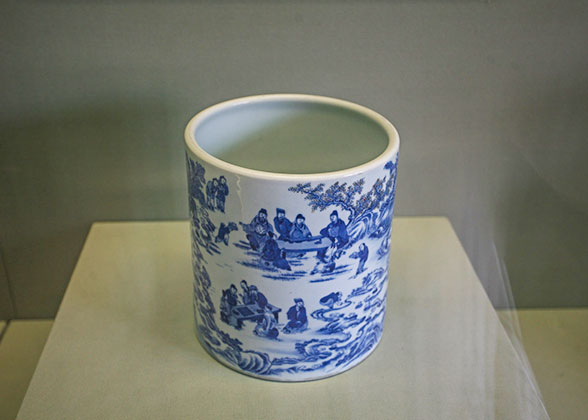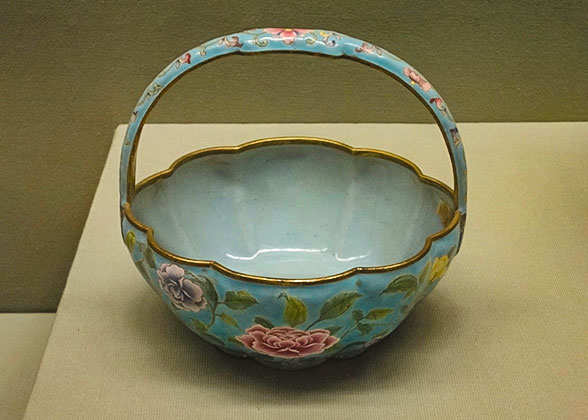Hall of Martial Valor (Wuyingdian)
Entering from the Meridian Gate, the south entrance of the Forbidden City, one will face the Inner Golden River Bridges. To the west of the bridges is the Gate of Prosperous Harmony (Xihemen) leading to the Hall of Martial Valor (Wuyingdian or Wuying Hall).
The Hall of Martial Valor, once for military use, now serves as the Pottery Gallery. If time permits, this hall and the Hall of Literary Glory (Wenhuadian) symmetrically standing to the east of the Golden River Bridges are good choices before you start further exploration along the central axis.
The whole building is an I-shaped structure with a lobby connecting the main hall and the back hall. The main hall facing south, five bays wide and three bays deep, is a single-eaved structure with yellow glazed tiles. The back is for Respect and Thinking (Jingsidian) in similar architectural style as the main hall in the front. In the northeast of the complex is the Room of Lasting Longevity (Hengshouzhai) and in the northwest the Bath Room. This hall and the Hall of Literary Glory echo from afar, one for military and the other for literary.
At the beginning of the Ming Dynasty (1368 - 1644), the emperor lived and worked in the Hall of Martial Valor, later moved to the Hall of Literary Glory. At the end of the Ming Dynasty, Li Zicheng, the peasant rebel leader, attacked Beijing and set up his regime here. However, the army slacked off so quickly that they couldn't fight against the Qing armies. It turned out to be a hasty enthronement in the Hall of Marital Valor on April 29 and a withdrawal the next day. Early in the years of the Qing army's control, the regent Duoergun arrived in Beijing first and took it as the working place. The first several Qing emperors held small-scaled ceremonies, religious rites here. In year 1669, the eighth year of the reign of Kangxi, the Emperor moved to live in it once due to the remodeling of the Hall of Supreme Harmony and the Palace of Heavenly Purity.
In the reign of Kangxi (1661-1722), a book store was opened in this hall. In 1701, the fortieth year of the reign of Kangxi, a large number of books were produced here. With dry point printing method and tailor-made papers, the books were pieces of art, words exquisite and pictures delicate. In the twentieth year of the reign of Daoguang (1820-1850), few books were published and those that were not published yet stored were all moved here for Respect and Thinking. In 1814, the nineteenth year of the reign of Jiaqing (1796-1820), after a check of the stored books, the sound ones were moved back to it, and the deformed ones were sold. In 1869, the eighth year of Tongzhi (1861-1875), it was damaged by a fire, books all destroyed. In the same year it was reconstructed.
 Pottery Gallery
Pottery Gallery
At present, the Hall of Martial Valor serves as the Pottery Gallery of the Forbidden City (Palace Museum). The Pottery Gallery exhibits more than 400 pieces of pottery treasures, including almost all the important pottery breeds in its development.
Tip: The Pottery Gallery shares the same opening hours with the Forbidden City, and requires no additional entrance fee.
The Hall of Martial Valor, once for military use, now serves as the Pottery Gallery. If time permits, this hall and the Hall of Literary Glory (Wenhuadian) symmetrically standing to the east of the Golden River Bridges are good choices before you start further exploration along the central axis.
The whole building is an I-shaped structure with a lobby connecting the main hall and the back hall. The main hall facing south, five bays wide and three bays deep, is a single-eaved structure with yellow glazed tiles. The back is for Respect and Thinking (Jingsidian) in similar architectural style as the main hall in the front. In the northeast of the complex is the Room of Lasting Longevity (Hengshouzhai) and in the northwest the Bath Room. This hall and the Hall of Literary Glory echo from afar, one for military and the other for literary.
At the beginning of the Ming Dynasty (1368 - 1644), the emperor lived and worked in the Hall of Martial Valor, later moved to the Hall of Literary Glory. At the end of the Ming Dynasty, Li Zicheng, the peasant rebel leader, attacked Beijing and set up his regime here. However, the army slacked off so quickly that they couldn't fight against the Qing armies. It turned out to be a hasty enthronement in the Hall of Marital Valor on April 29 and a withdrawal the next day. Early in the years of the Qing army's control, the regent Duoergun arrived in Beijing first and took it as the working place. The first several Qing emperors held small-scaled ceremonies, religious rites here. In year 1669, the eighth year of the reign of Kangxi, the Emperor moved to live in it once due to the remodeling of the Hall of Supreme Harmony and the Palace of Heavenly Purity.
In the reign of Kangxi (1661-1722), a book store was opened in this hall. In 1701, the fortieth year of the reign of Kangxi, a large number of books were produced here. With dry point printing method and tailor-made papers, the books were pieces of art, words exquisite and pictures delicate. In the twentieth year of the reign of Daoguang (1820-1850), few books were published and those that were not published yet stored were all moved here for Respect and Thinking. In 1814, the nineteenth year of the reign of Jiaqing (1796-1820), after a check of the stored books, the sound ones were moved back to it, and the deformed ones were sold. In 1869, the eighth year of Tongzhi (1861-1875), it was damaged by a fire, books all destroyed. In the same year it was reconstructed.
At present, the Hall of Martial Valor serves as the Pottery Gallery of the Forbidden City (Palace Museum). The Pottery Gallery exhibits more than 400 pieces of pottery treasures, including almost all the important pottery breeds in its development.
Tip: The Pottery Gallery shares the same opening hours with the Forbidden City, and requires no additional entrance fee.
 |  |
Go east back to the Duanhong Bridge and Taihemen Square, and continue the tour along the central axis.
Go west to see the Hall of Embodied Treasures (Baoyunlou) exhibiting the development history of the Palace Museum.
How to visit the Forbidden City
- Last updated on Nov. 24, 2023 by Kate Liu -